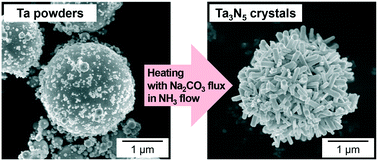Prismatic Ta3N5-composed spheres produced by self-sacrificial template-like conversion of Ta particles via Na2CO3 flux†
Abstract
Spatial charge separation on the anisotropic facets of photocatalyst particles can enhance their photocatalytic performance by reducing the probability of electron–hole recombination. This study investigated the Na2CO3 flux growth of faceted Ta3N5 crystals using Ta powders as the Ta source. An extremely small amount of Na2CO3 flux led to the growth of well-formed prismatic Ta3N5 crystals as a single-phase. The prismatic crystals formed spherical aggregates with a size and shape similar to those of the raw Ta powders. Although Ta3N5 crystals were also grown from Ta2O5 and TaCl5 in Na2CO3 flux, the products were neither well-formed particles nor single-phase Ta3N5, which suggests that Ta powder dissolved more easily in Na2CO3 flux. The growth mechanism of the spherical Ta3N5 aggregates was investigated by evaluating the crystal growth at different heating temperatures and times. Cross-sectional observation of the products indicated that the raw Ta powder grains acted as a self-sacrificial template, thus determining the size and shape of the final product. The Ta3N5 crystals modified with CoOx co-catalysts exhibited photocatalytic activity for O2 evolution under visible light irradiation.



 Please wait while we load your content...
Please wait while we load your content...